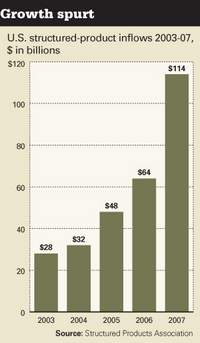By BRIAN WARGO, Registered Rep. Magazine
(Originally published March 1, 2008)
Long a Favorite of Investors in Europe, structured products are rapidly gaining popularity in the United States. Last year, $114 billion in structured products were issued in the U.S., according to the Structured Products Association.
That's a 78 percent jump over 2006 — and dwarfs the $32 billion in structured products issued in 2004. Previously the sole purview of sophisticated high-net-worth investors in the U.S., they have begun filtering into the mainstream. The retail market bought some $58 billion — or about half — of the structured products issued in 2007.
Structured products combine financial instruments, typically bonds and derivatives, into a package that allows investors to bet on the direction of stocks, bonds and other investments. They are used to both hedge and to speculate, and typically pay an interest or coupon rate substantially above the prevailing market rate. Many of them also cap or limit upside returns, particularly if principal protection is offered.
One reason demand has picked up so much over the last three years is that a number of new financial institutions have entered the market, says Kumar Doraiswami, managing director and head of sales for Natixis Capital Markets. There are 30 active issuers today, up from 10 five years ago.
That has improved liquidity and helped to cut transaction costs — two issues that have long concerned investors and advisors, he says. The increased number of offerings, and the accompanying press coverage, has also helped generate greater awareness of the benefits and risks of the (relatively new) instruments, says Philippe El-Asmar, managing director and head of investor solutions for the Americas region for Barclays Capital.
El-Asmar believes structured products will continue to win greater appeal, particularly those that give investors exposure to attractive but risky markets, such as emerging equities or commodities, but protect them on the downside. Those frustrated with a 3.5-percent return on bonds, for example, may appreciate a product that protects their principal while giving them 80 percent of the upside in the market, he says.
Current market conditions could also enhance their appeal. Randy Pegg, executive vice president of Colorado-based Fixed Income Securities (FIS), says the U.S. structured-product industry witnessed tremendous growth during the market correction of 2000 to 2001 as more investors realized they could protect their downside, yet remain invested for some upside.
The same reasoning may now be at play, according to Pegg. “We have experienced increased demand with the recent market sell-off,” he says. “Investors have learned that to make money in the market, you must be in for the up days. When they know they have principal protection, investors can stay invested longer and still sleep at night — especially during turbulent times.”
For the full article, please click here.
Wednesday, June 11, 2008
Subscribe to:
Post Comments (Atom)




No comments:
Post a Comment